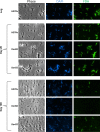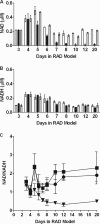The Mycobacterium tuberculosis DosR regulon assists in metabolic homeostasis and enables rapid recovery from nonrespiring dormancy
- PMID: 20023019
- PMCID: PMC2832541
- DOI: 10.1128/JB.00926-09
The Mycobacterium tuberculosis DosR regulon assists in metabolic homeostasis and enables rapid recovery from nonrespiring dormancy
Abstract
Mycobacterium tuberculosis survives in latently infected individuals, likely in a nonreplicating or dormancy-like state. The M. tuberculosis DosR regulon is a genetic program induced by conditions that inhibit aerobic respiration and prevent bacillus replication. In this study, we used a mutant incapable of DosR regulon induction to investigate the contribution of this regulon to bacterial metabolism during anaerobic dormancy. Our results confirm that the DosR regulon is essential for M. tuberculosis survival during anaerobic dormancy and demonstrate that it is required for metabolic processes that occur upon entry into and throughout the dormant state. Specifically, we showed that regulon mechanisms shift metabolism away from aerobic respiration in the face of dwindling oxygen availability and are required for maintaining energy levels and redox balance as the culture becomes anaerobic. We also demonstrated that the DosR regulon is crucial for rapid resumption of growth once M. tuberculosis exits an anaerobic or nitric oxide-induced nonrespiring state. In summary, the DosR regulon encodes novel metabolic mechanisms essential for M. tuberculosis to survive in the absence of respiration and to successfully transition rapidly between respiring and nonrespiring conditions without loss of viability.
Figures







Similar articles
-
Unique roles of DosT and DosS in DosR regulon induction and Mycobacterium tuberculosis dormancy.Infect Immun. 2009 Aug;77(8):3258-63. doi: 10.1128/IAI.01449-08. Epub 2009 Jun 1. Infect Immun. 2009. PMID: 19487478 Free PMC article.
-
Anaerobic Mycobacterium tuberculosis Cell Death Stems from Intracellular Acidification Mitigated by the DosR Regulon.J Bacteriol. 2017 Oct 31;199(23):e00320-17. doi: 10.1128/JB.00320-17. Print 2017 Dec 1. J Bacteriol. 2017. PMID: 28874407 Free PMC article.
-
The DosR regulon of M. tuberculosis and antibacterial tolerance.Tuberculosis (Edinb). 2009 Jul;89(4):310-6. doi: 10.1016/j.tube.2009.06.001. Epub 2009 Jul 3. Tuberculosis (Edinb). 2009. PMID: 19577518 Free PMC article.
-
How Mycobacterium tuberculosis goes to sleep: the dormancy survival regulator DosR a decade later.Future Microbiol. 2012 Apr;7(4):513-8. doi: 10.2217/fmb.12.14. Future Microbiol. 2012. PMID: 22439727 Review.
-
Immunogenic potential of latency associated antigens against Mycobacterium tuberculosis.Vaccine. 2014 Feb 3;32(6):712-6. doi: 10.1016/j.vaccine.2013.11.065. Epub 2013 Dec 2. Vaccine. 2014. PMID: 24300592 Review.
Cited by
-
Regulatory role of Mycobacterium tuberculosis MtrA on dormancy/resuscitation revealed by a novel target gene-mining strategy.Front Microbiol. 2024 Jun 17;15:1415554. doi: 10.3389/fmicb.2024.1415554. eCollection 2024. Front Microbiol. 2024. PMID: 38952446 Free PMC article.
-
Mycobacterium tuberculosis precursor rRNA as a measure of treatment-shortening activity of drugs and regimens.Nat Commun. 2021 May 18;12(1):2899. doi: 10.1038/s41467-021-22833-6. Nat Commun. 2021. PMID: 34006838 Free PMC article.
-
Noise in a Metabolic Pathway Leads to Persister Formation in Mycobacterium tuberculosis.Microbiol Spectr. 2022 Oct 26;10(5):e0294822. doi: 10.1128/spectrum.02948-22. Epub 2022 Oct 4. Microbiol Spectr. 2022. PMID: 36194154 Free PMC article.
-
PrrA modulates Mycobacterium tuberculosis response to multiple environmental cues and is critically regulated by serine/threonine protein kinases.PLoS Genet. 2022 Aug 1;18(8):e1010331. doi: 10.1371/journal.pgen.1010331. eCollection 2022 Aug. PLoS Genet. 2022. PMID: 35913986 Free PMC article.
-
The Role of Integration Host Factor in Escherichia coli Persister Formation.mBio. 2022 Feb 22;13(1):e0342021. doi: 10.1128/mbio.03420-21. Epub 2022 Jan 4. mBio. 2022. PMID: 34982597 Free PMC article.
References
-
- Aly, S., K. Wagner, C. Keller, S. Malm, A. Malzan, S. Brandau, F. C. Bange, and S. Ehlers. 2006. Oxygen status of lung granulomas in Mycobacterium tuberculosis-infected mice. J. Pathol. 210:298-305. - PubMed
-
- Black, G. F., B. A. Thiel, M. Ota, S. K. Parida, R. Adegbola, W. H. Boom, H. M. Dockrell, K. L. Franken, A. H. Friggen, P. C. Hill, M. R. Klein, M. K. Lalor, H. Mayanja, G. Schoolnik, K. Stanley, K. Weldingh, S. H. Kaufmann, G. Walzl, and T. H. Ottenhoff. 2009. Immunogenicity of novel DosR regulon-encoded candidate antigens of Mycobacterium tuberculosis in three high-burden populations in Africa. Clin. Vaccine Immunol. 16:1203-1212. - PMC - PubMed
Publication types
MeSH terms
Substances
Grants and funding
LinkOut - more resources
Full Text Sources
Other Literature Sources
Molecular Biology Databases

